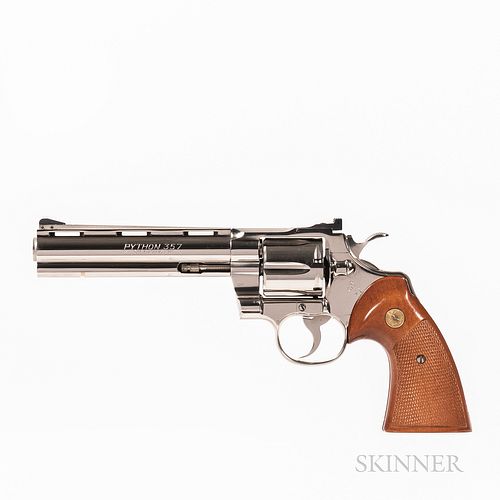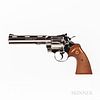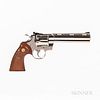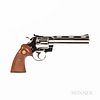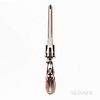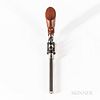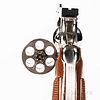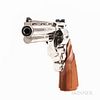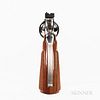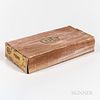Colt Python Double-action Revolver Acquired for the James Bond Film, The Man with the Golden Gun
Lot 190
About Seller
Bonhams Skinner
274 Cedar Hill Street
Marlborough, MA 01752
United States
Founded over four decades ago, Bonhams Skinner offers more than 60 auctions annually. Bonhams Skinner auctions reach an international audience and showcase the unique, rare, and beautiful in dozens of categories, including the fine and decorative arts, jewelry, modern design, musical instruments, sc...Read more
Categories
Estimate:
$4,000 - $6,000
Absentee vs Live bid
Two ways to bid:
- Leave a max absentee bid and the platform will bid on your behalf up to your maximum bid during the live auction.
- Bid live during the auction and your bids will be submitted real-time to the auctioneer.
Bid Increments
| Price | Bid Increment |
|---|---|
| $0 | $10 |
| $100 | $25 |
| $500 | $50 |
| $1,000 | $100 |
| $3,000 | $250 |
| $5,000 | $500 |
| $10,000 | $1,000 |
| $30,000 | $2,500 |
| $50,000 | $5,000 |
| $100,000 | $10,000 |
| $300,000 | $25,000 |
| $500,000 | $50,000 |
| $1,000,000 | $100,000 |
About Auction
By Bonhams Skinner
Oct 29, 2021
Set Reminder
2021-10-29 10:00:00
2021-10-29 10:00:00
America/New_York
Bidsquare
Bidsquare : Historic Arms & Militaria
https://www.bidsquare.com/auctions/skinner/historic-arms-militaria-7693
The William Rose collection features nearly 180 lots of rare and important 17th & 18thc. muskets, bayonets, pistols, swords, powder horns, accoutrements and documents used by British, French, and American forces who served in America's colonial wars and American Revolution. Bonhams Skinner bidsquare@bonhamsskinner.com
The William Rose collection features nearly 180 lots of rare and important 17th & 18thc. muskets, bayonets, pistols, swords, powder horns, accoutrements and documents used by British, French, and American forces who served in America's colonial wars and American Revolution. Bonhams Skinner bidsquare@bonhamsskinner.com
- Lot Description
Colt Python Double-action Revolver Acquired for the James Bond Film, The Man with the Golden Gun, 1974, serial number E60096, .357 Magnum caliber, nickel finish, 6 in. barrel with black ramp sight secured by two pins to the vented rib with matte finish top, the left side of the frame marked with the Colt rampant horse logo, "J" at the rear of the trigger guard, and combined "VP" within an inverted triangle at the front of the trigger guard, the left side of the barrel marked "PYTHON .357/[star] .357 MAGNUM CTG. [star]," the right side of the barrel marked "COLT'S PT. F.A. MFG. CO. HARTFORD, CONN. U.S.A.," serial numbers stamped on the frame inside the crane opening and on the crane itself, the frame also stamped "P" and "N" below the serial number, two-piece walnut grip with checkered plateaus, gold "COLT" and rampant horse medallions, and thumb recesses, polished grooved trigger, grooved back strap, adjustable rear sight, wide diamond textured hammer, with original correspondingly numbered Colt retail box, Colt Archives documentation letter, and statement of provenance from the consignor, overall lg. 11 1/2 in.
Provenance: Shipped from the Colt Factory March 25, 1974, to R.C.B.S. Gun Shop, Oroville, California, for "Mr. Roushon [sic]"; given to the consignor by Claire Russhon, August 1982.
Charles Russhon, Military Liaison and Technical Advisor to the James Bond Films
Charles Russhon (March 23, 1911-June 26, 1982) was a retired United States Air Force lieutenant colonel who served in the China-Burma-India theater of World War II and was the first American to photograph Hiroshima after the atomic bomb attack in 1945. He had a reputation as a man who could accomplish the impossible. In this capacity, using his extensive connections within American and international politics, Russhon served as an indispensable (but usually uncredited) military liaison and technical advisor on at least five James Bond films of the 1960s and 1970s. For the 1964 film From Russia with Love, he negotiated with Turkish authorities to arrange permission for the movie's production team to film several key locations in Istanbul. Using his connections within the United States government and personal connections at the White House, Russhon secured permission from the U.S. Army and four other government agencies to allow key scenes in the movie Goldfinger to be filmed in and around the U.S. Army base at Fort Knox, Kentucky. In addition, he was able to secure free use of several Piper aircraft that were used by Pussy Galore's Flying Circus aerial acrobats that planned to release nerve gas over the base to disable the military forces allowing Auric Goldfinger (Gert Frobe) to render useless the gold within the gold depository. As a subtle note of thanks for his extraordinary efforts, the film crew mounted a sign on one of the base's buildings that read "Welcome to Fort Knox Gen. Russhon" which is visible in a scene prior to the attack. Charles Russhon is credited as a Technical Advisor in the film's closing credits.
For the 1965 film Thunderball, Charles Russhon once again used his connections to enable the film makers to produce some of the most iconic scenes in the series' over half-century history. He used his contacts in the U.S. Army to secure the use of a Bell Rocket belt that James Bond (Sean Connery) used to escape Jacques Boitier's (Bob Simon) chateau in the film's pre-title sequence. Russhon acquired over $90,000 worth of free scuba diving equipment from AMF (American Machine Foundry) for use in the underwater battles. He arranged for U.S. Air Force combat divers to parachute into the sea and the U.S. Coast Guard to participate in the final battle sequences in the film. And in the final scene where James Bond (Sean Connery) and Dominique "Domino" Derval (Claudine Auger) are whisked away from the life raft, it was Charles Russhon who arranged for the U.S. Navy's experimental "Skyhook" rescue system to be used to dramatic effect. Charles Russhon appears in the film (uncredited) as the American Air Force officer seen leaning on a desk in a scene where M (Bernard Lee), Miss Moneypenny (Lois Maxwell) and government officials are listening to a recording where Ernst Stavro Blofeld, the leader of S.P.E.C.T.R.E. (voiced by Eric Pohlmann) makes his ransom demand for the return of stolen nuclear missiles.
Russhon used his military connections in Japan to help secure transportation of film crews and equipment to remote locations during the production of You Only Live Twice. He also used his connections to enable Gyrojet firearms into the United Kingdom when filming scenes for the film at Pinewood Studios. And using his connections within the New York City police department Russhon arranged for the department's cooperation so that important scenes in the 1973 film, Live and Let Die, could be filmed in Manhattan. Charles Russhon's ability to make the seemingly impossible possible, earned him the nickname "Mr. Fixit" from James Bond actor Roger Moore.
The Man with the Golden Gun
Shortly after Charles Russhon's death in late June 1982, Charles' wife, Claire, reached out to close friend Alan M. Shoemaker to help her disperse a large collection of firearms he had amassed during his career. In appreciation for his efforts, Claire offered Alan any firearm he wished as a gift. Alan chose a Colt Python revolver to which Claire replied "oh, Charlie told me he got that one specifically for The Man with the Golden Gun." Years later Mr. Shoemaker, in an effort to learn more about the revolver, obtained a letter on the firearm's history from the Colt archives. The letter dated June 15, 2015, states that serial number E60096, a .357 Magnum caliber firearm with a six-inch barrel and nickel finish was shipped to R.C.B.S. Gun Shop, Oroville, California for Mr. Roushon [sic] on March 25, 1974. The shipment included two guns. The whereabouts of the second firearm is unknown.
While no official printed or online sources mention Charles Russhon's involvement with the filming of The Man with the Golden Gun, his intimate connection to numerous James Bond films is well documented, including The Man with the Golden Gun's predecessor, Live and Let Die. His work to obtain firearms for the films is also documented through his efforts to bring Gyrojet arms into England for You Only Live Twice.
The Man with the Golden Gun, released December 19, 1974, is the ninth film in the Bond series and centers around James Bond's (Roger Moore) assignment to retrieve a highly efficient device for transforming sunlight into useable energy that has the potential to solve a world-wide energy crisis. The device is controlled by classic Bond villain, Francisco Scaramanga (Christopher Lee). Principal filming began in early April 1974 at locations in Thailand and Hong Kong. Filming moved to Pinewood Studios in England in late June. In late July the interior scenes of Scaramanga's island were filmed. While there were a large number makes and models of firearm used throughout the film, the only scene where a Colt Python revolver is seen is in Francisco Scaramanga's "Fun House" where he would hire professional killers to come to his island lair to attempt to kill him as a way of keeping himself trained as a keen shot. In the pre-title sequence, Scaramanga enters his home to find a Chicago-style gangster (Mark Lawrence) waiting in ambush to kill him and collect a sizeable reward. Just as the gangster is about to shoot Scaramanga, Scaramanga's servant, Nick Nack (Herve Villechaize), turns off the lights in the room forcing the gangster and Scaramanga to search for each other in a darkened room. Soon Scaramanga tosses a weight to distract the gangster and then leaps toward a built-in wall cabinet holding a large collection of handguns mounted horizontally inside. A brief close up shot of the cabinet at approximately 4 minutes, 8 to 9 seconds into the film reveals through a wire mesh door a view of three revolvers above two ornately decorated flintlock pistols. The revolvers are a nickel-plated Colt Detective Special, a nickel-plated Smith & Wesson Model 29, and partially obscured by the frames of the opposing closed doors, a Colt Python. In the scene the Python's walnut grip is plainly recognizable with the thumb recess at the top, the gold Colt medallion, grip screw hole, and outline of the checkering all visible. The frame and cylinder are visible up to just forward of the trigger guard. The hammer appears to be bright, and the rear sight is visible. The closed door frame obscures most of the barrel, but the muzzle and underlug can be seen projecting just beyond nearly touching the butt of the Detective Special. The Python appears to have a 6-inch barrel.
The Colt Detective Special and Python revolvers are both pointing to the left. The lighting in the scene is filtered red, subdued and moderately strong shadows are evident. In such lighting, the position of the handgun with respect to the direction of the light source has a great impact on the gun's surface appearance. While it is clear from highlights on some of the rounded areas of the cylinder and barrel that the Detective Special has a nickel-plated surface, the surface of the revolver is generally dark. The Python, also orientated in the same direction and further blocked by the door frames, also appears to have a generally dark surface, but brighter highlights also appear on the trigger guard, cylinder, top of the frame and muzzle. The Smith & Wesson, on the other hand, which is pointed to the right, catches the light in an entirely different way and virtually every surface of the firearm is bright.
This brief two-second sequence is the only time a Colt Python revolver is visible in The Man with the Golden Gun. Regardless how one interprets the lighting and its effect on the Colt Python in the film, the history of the revolver offered in this lot as described by the wife of its original owner is tantalizing. The date it was acquired by Russhon corresponds well with the movie's filming timeline. The fact that Russhon was a person whom the series producers could rely upon to acquire unique items and get them to locations is well documented. Above all, the Python was owned by one of the most influential advisors to the classic James Bond films of the 1960s and early 1970s. Were it not for Charles Russhon's connections, many of the most iconic sequences in the entire film series may have never happened.
Note: FFL.Condition
Condition: Revolver is in excellent overall condition with subtle blemishes on the muzzle, turn line at the back of cylinder, light scratches associated with the cylinder release, a small scratch on the underside of the upper portion of the left grip, bright barrel with sharp rifling, crisp action, tight cylinder lock up. Consignor states that to his knowledge, only about twenty cartridges have been fired from the revolver and the front of the cylinder has minor staining as a result of that limited use.
The box is worn and has fraying to the edges and corners; flap with model and serial number label has been reinforced with cellophane tape, other end flaps are detached, but present.
Any condition statement is given as a courtesy to a client, is only an opinion and should not be treated as a statement of fact. Skinner Inc. shall have no responsibility for any error or omission. The absence of a condition statement does not imply that the lot is in perfect condition or completely free from wear and tear, imperfections or the effects of aging. - Shipping Info
-
Please visit http://www.skinnerinc.com/services/payment-and-shipping/ for information regarding the collection of items purchased at auction.
-
- Buyer's Premium



 EUR
EUR CAD
CAD AUD
AUD GBP
GBP MXN
MXN HKD
HKD CNY
CNY MYR
MYR SEK
SEK SGD
SGD CHF
CHF THB
THB